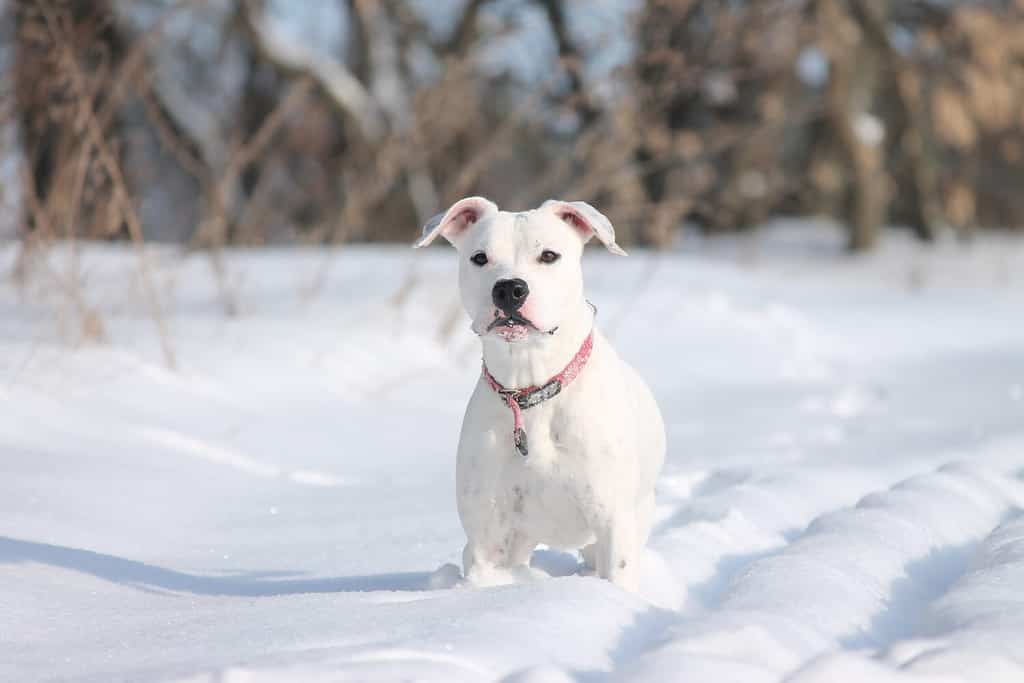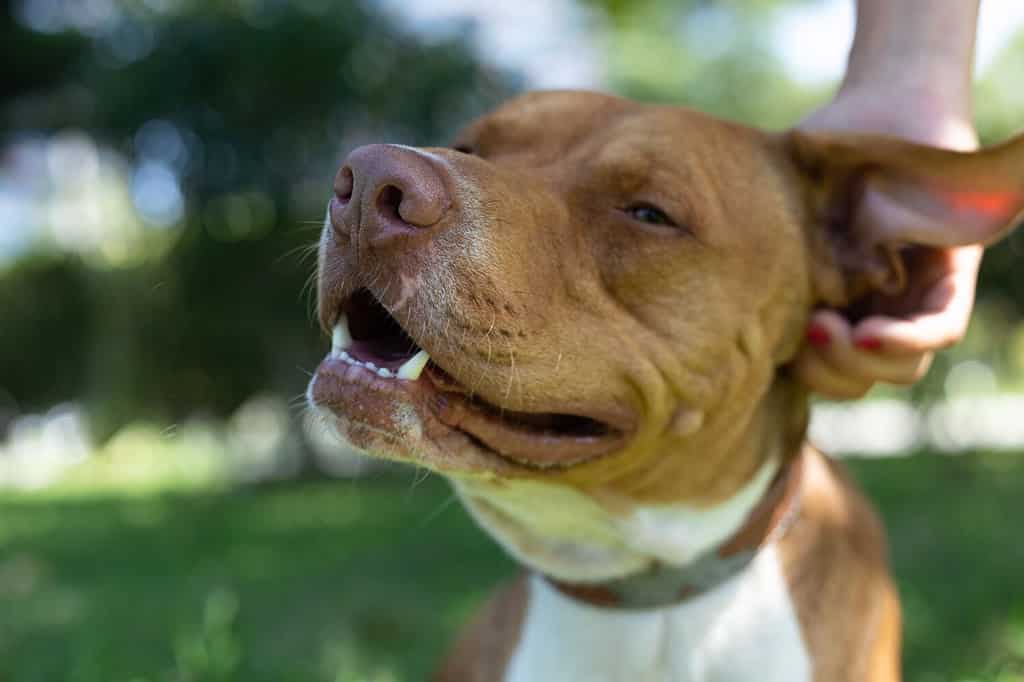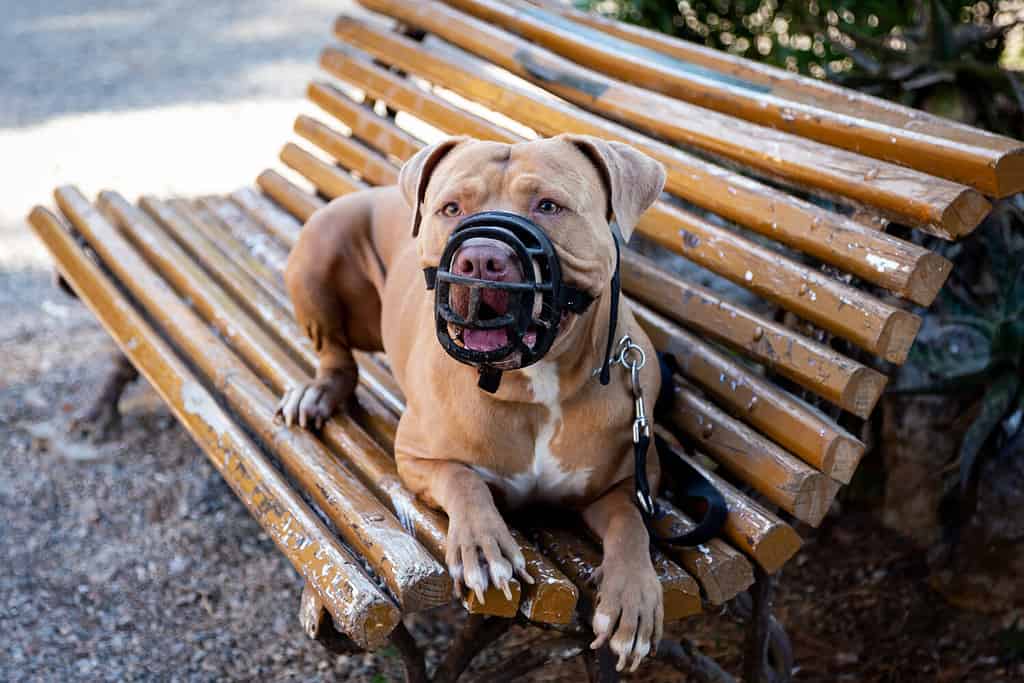Training your Pit Bull is essential due to the dog’s reputation–unfortunately, they’re going to be judged even more harshly than other breeds for any misbehavior.
The most important things to train your Pit Bull are basic cues (sit, down, stay) and safety cues (leave it, drop it, wait before running out of the door). It’s also important to begin socializing your Pit Bull puppy the moment you bring them home. The more positive experiences they have while young, the more confident and well-behaved they’ll be as adults.
This Pit Bull training guide will discuss tips, common training mistakes, and more.
Are Pit Bulls Easy to Train?

Pit Bulls are easy to train but require experienced dog owners.
©Anna_Bondarenko/Shutterstock.com
Pit Bulls are smart, biddable dogs. They tend to enjoy training and love to please their people. However, there are some common training challenges in the breed.
The first is dog aggression. Not all Pit Bulls are dog aggressive, but it is common due to their history of being bred for dog fighting.
Some Pit Bulls have strong guarding instincts which can also pose challenges if they guard inappropriately, such as showing aggression to strangers in public or resource guarding their toys.
These issues tend to be amplified by the dogs’ size and strength, so it’s important to socialize, train, and manage your Pit Bull well.
How do You Discipline a Pit Bull?
The biggest mistake you can make is to try to dominate your Pit Bull or be the “alpha dog.” No dog breed responds well to this kind of training, and it tends to foster fear and aggression.
If your Pit Bull does something wrong, redirection is usually the best method to correct them. For instance, biting puppies should be redirected to their toys whenever they nip at your hands.
In addition, much of our dog’s misbehavior is our fault and indicates that we aren’t managing them well. If your Pit Bull eats food left out on the counter, no need for discipline! Say nothing to your dog, as it isn’t their fault. Remember next time to put the food away before leaving the room.
If they pee in the house, watch them more closely going forward and bring them outside for potty breaks more often.
There is never a need to scold your dog or hurt them in any way–which includes the use of aversive tools like prong collars or shock collars.
Socializing Your Pit Bull

Early socialization is key to a happy and confident Pit Bull.
©Tosha Bu/Shutterstock.com
Socialization means introducing your Pit Bull to a variety of experiences. It includes being around people of different genders and races, experiencing loud noises like the vacuum or lawn mower, and seeing people wearing or using items like canes, hats, and hoods.
Adult dogs who haven’t experienced these things can become scared. Poorly socialized Pit Bulls can be fearful or even aggressive, especially in public or when guests come over.
Keep in mind that your dog doesn’t need to interact with a bunch of people or other dogs to become well-socialized. Being able to calmly walk past people and other dogs is enough!
How do You Raise a Calm Pit Bull?
Socialization is a big step toward raising a calm Pit Bull, but it isn’t all that’s needed. You’ll also want to teach them good manners, like not lunging during walks and not jumping on people.
These are high-energy dogs who will always need plenty of daily exercise. Pits are also smart and need mental enrichment to prevent boredom.
A combination of good training and socialization, daily exercise, and plenty of mental enrichment will lead to a confident and calm Pit Bull who other people will enjoy interacting with.
How to Train a Pit Bull to be Dog Friendly
If your Pit Bull has shown dog aggression and especially if they’ve bitten, you should not allow them around other dogs without the help of a force-free trainer or dog behaviorist who is experienced in aggression cases. It’s not worth risking another dog being hurt in order to train them.
The best thing to do in these cases is to manage your dog, meaning making sure they’re never around other dogs without a muzzle and leash.
Even Pit Bulls who’ve never bitten shouldn’t be taken to places like dog parks or daycare, as these really aren’t good ideas for any dog! It’s safer to set up playdates with known dogs who your Pit gets along with, have responsible owners, and are friendly and vaccinated.
With Pit Bulls’ tendency toward dog aggression, it’s extra important to know dog body language before attempting any introductions. Both dogs should be leashed and in your control in case something goes wrong, and introductions should be made slowly.
Walking together is often a great way to introduce two dogs since they can share an activity in a neutral environment, and don’t need to interact with one another.
Basic Cues for Pit Bull Puppies to Learn

Focus on developing a good foundation with your puppy and don’t worry if they aren’t perfect!
©dezy/Shutterstock.com
Begin training your Pit Bull puppy when you bring them home, but remember to keep your expectations in line with their age and development. For instance, a two-month-old puppy has a short attention span and likely cannot succeed at a prolonged “stay.”
Your focus at this age should be on laying down a foundation, socializing your dog to new experiences, and teaching safety cues.
Some of the first cues to teach include:
- Sit
- Down (lay down)
- Stay
- Leave it
- Drop it
- Recall (coming when called)
- Wait (before going outside, eating dinner, etc.)
- Off (when jumping on people)
- Leash manners
Advanced Cues and Dog Sports
Daily training is a great way to provide mental enrichment for your Pit Bull. They’re very handler-focused and tend to excel at obedience and dog sports.
You can pick and choose what you teach at home, focusing on either fun or useful cues or a mix of both. You can also pay for training classes to learn from a professional and get some guidance if you’re unsure what to teach.
Your Pittie might also enjoy lure coursing, agility, or other dog sports. Make sure your pup is fully grown before participating in strenuous activities, especially jumping, to avoid overworking their growing joints and causing issues like hip dysplasia.
Common Pit Bull Training Mistakes

Avoiding common Pit Bull training mistakes can make life easier for you and your pup!
©entreguin/Shutterstock.com
Here are some common mistakes people make when training their Pit Bulls:
Not Providing Enough Exercise or Mental Enrichment
A tired dog is a well-behaved dog, and bored pups will get into mischief! You’re almost bound to have behavioral problems if you don’t first meet your Pit Bull’s basic needs.
Training for Aggression, Bite work, or Guarding
This can be incredibly dangerous and result in a dog who is inappropriately aggressive. Remember that Pit Bulls make good deterrents on their own and it’s unlikely they’ll need to truly guard you or your home.
Using Compulsion Training or Other Aversive Training Methods
You do not need to dominate your Pit Bull–this is outdated, dangerous advice. Aversive methods and tools should be avoided as there are much more humane and effective ways to train your dog. Bad training methods can cause fear and aggression so, despite popular myth, they’re even more poorly suited toward big, powerful dogs than your average breed.
Not Teaching Your Pit Bull What you Want Them to Do
Constantly saying no and never providing alternatives, or never praising what your dog does right, leads to confusion. For every no, you should be saying yes to something else. For instance, you might want them to go lay on their bed instead of barking and jumping on guests.
Setting Your Dog up to Fail
Examples include leaving food out and expecting them not to eat it, not putting a dog who tends to door-dash into another room before opening the front door, etc. When possible, and especially when misbehavior can be dangerous, we want to completely eliminate the possibility that our dog will misbehave.
Walking Off-Leash Without Reliable Recall
Pit Bulls’ tendency toward dog aggression and their strong prey drive mean that you must be very sure they’ll behave before allowing them off leash. There is a good chance they will run off or get into other types of trouble, otherwise.
Taking Things From Your Pit Bull to Prevent Resource Guarding
This, sticking your hand in their bowl while they eat, and similar methods all increase a dog’s chances of becoming a resource guarder. You want to build their trust in you to not take their things and to give them even higher value rewards when you do need to take something. These methods betray that trust instead.
Introducing Dogs too Quickly and Without Understanding Dog Body Language
As we discussed above, dog introductions must be done slowly and properly. Quick introductions can damage the dogs’ relationship long-term and can result in fights.
The photo featured at the top of this post is © Anna_Bondarenko/Shutterstock.com
Ready to discover the top 10 cutest dog breeds in the entire world?
How about the fastest dogs, the largest dogs and those that are -- quite frankly -- just the kindest dogs on the planet? Each day, AZ Animals sends out lists just like this to our thousands of email subscribers. And the best part? It's FREE. Join today by entering your email below.
Thank you for reading! Have some feedback for us? Contact the AZ Animals editorial team.






